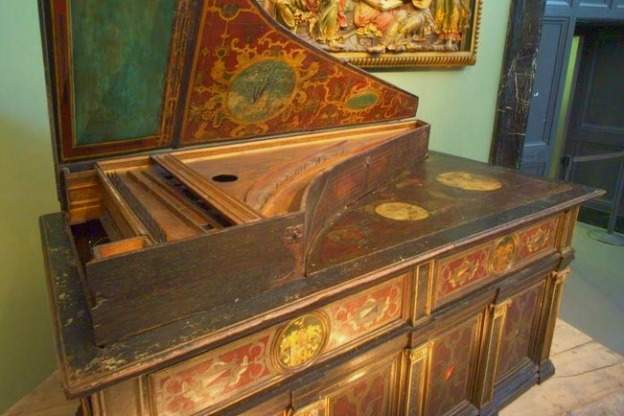
Claviorganum
The first time you see a claviorganum, you might feel like you're seeing a mythical creature. Like the part lion-part man griffen, or part girl-part fish mermaid, the clavigorganum is part harpsichord and part organ. Developed in the 15th and 16th centuries, the claviorganum doesn't have its own distinct, specific repertory, and the extent to which it was used-where, and for what purpose, and how often-isn't abundantly clear. The construction of the claviorganum was never standardized either. The few examples of original instruments, or descriptions of them that are left, survive in different shapes and sizes with varying features and functions and abilities.
Angeles  O Calandrias
A 2014 CD titled Angeles  O Calandrias, from the Lindoro label offers a portrait of the instrument as it might have been heard in late Renaissance and early Baroque era Spain.  The liner note of this disc explains how the performers chose music by 16th and 17th c. Spanish composers for their recording. It's a sacred program, taking as its cue, scholarship that supports the use of the the claviorganum for Holy Week and for festal celebrations. Especially in Royal courts and Spanish Cathedrals, the instrument seems to have been found during this period in cities like Santiago de Compostela and Seville. Not only that, but a 1627 account documented the use of claviorgana along with bassoon and cornetto as accompaniment for singers in sacred concerts of motets and villancicos performed after Mass. And thus, we have the basis for this CD: a sacred concert of such texts and tunes loosely recreated: Mark Chambers and Javier Jimenez sing, Barbara Sela plays bassoon, Arnau Rodon performs on cornetto, and *Andres Cea plays the claviorganum.
The particular claviorganum on this CD has three separate manuals, or keyboards: the top one which makes the harpsichord sound, the bottom one which separately operates the organ, and in addition, a middle manual which couples the harpsichord to the organ so that a single key can make both sound at once. There's also a 27 note pedalboard attached to the organ that can be operated by the feet, as well as a tremulant, or vibrato effect, and a Regal stop as well.
Aupre de vous
Another 2014 recording with the title, Aupre de vous, on the label L'Encelade also features this hybrid instrument. Unlike the three manuals on the previous disc, the claviorganum on this recording appears to have only two, and pedals are also absent. This is probably more the norm, at least in terms of what we know from surviving claviorgana examples. In instruments like these, the two keyboards would likely be permanently joined together-and as a result, the organ part of the instrument couldn't sound without the harpsichord keyboard.
The claviorganum on this CD is performed by Pierre Gallon. The instrument he plays was built by Emile Jobin and Quentin Blumenroeder after on a model first constructed in 1528. Gallon is also joined on several tracks  by lutenist, Thomas Dunford, and keyboardist, Freddy Eichelberger.
The selections on this recording all come from music collected and printed by Pierre Attaingnant in 16th c. Paris. Attaignant's success as a music printer stemmed from his process of notation which required only one impression of the type. You might be familiar with another famous printer of the time named Petrucci. Petrucci's method of printing required a page to be put two times through the press, and though it produced a more refined result, his process was more cumbersome than that of Attaignant who could turn out sheet music much more quickly and cheaply. The books Attaignant published had both sacred and secular works; works that church organists could use on the job, but also dance tunes, and versions of popular songs. And though the songs included are all performed in their keyboard transcriptions, a nice surprise in the CD booklet is the inclusion of the vocal texts from which these instrumental versions derive.
*The audio of this podcast mis-identifies the claviorganum player as Mark Chambers. Â It is corrected in this post as Andres Cea.









